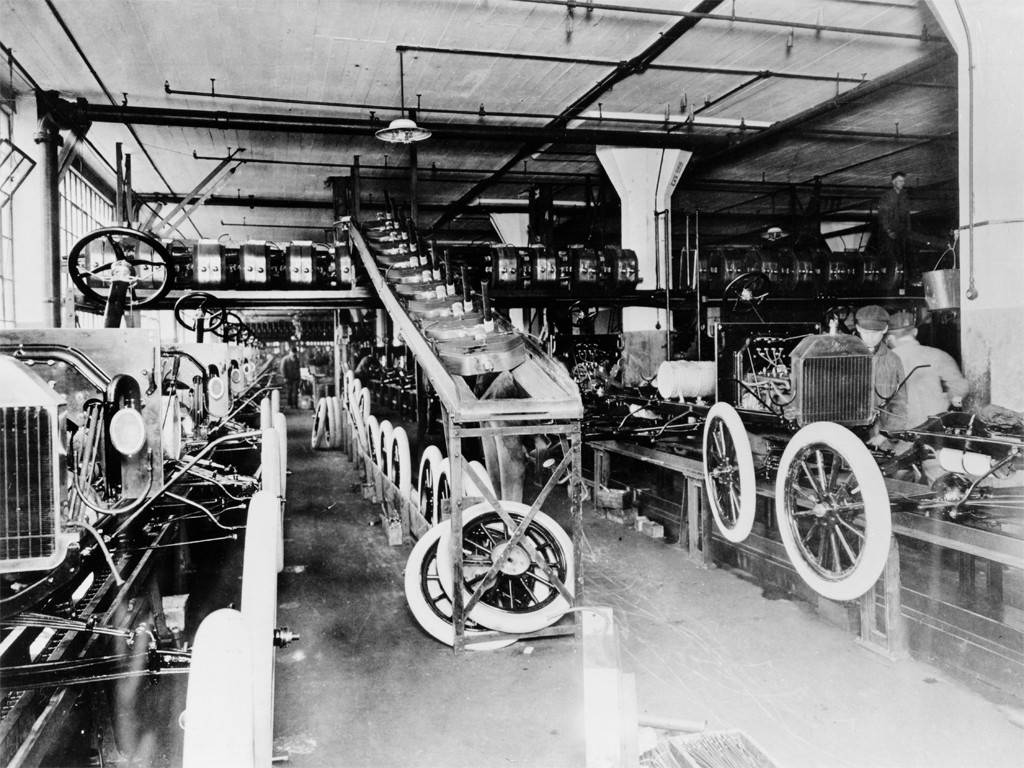Art and technology have evolved side by side through history. I have begun to understand the connection between math and science and art in the previous weeks. Still, I think it is important to note that this connection has been present for decades, and the two entities have grown with each other through the means of mechanics and technology.
 |
| Henry Ford's assembly line |
At the beginning of the 20th-century, art became more modernized through the age of mechanical reproduction and Henry Ford's development of the assembly line. Maša Jazbec explained in her presentation that Ford's implementation of the assembly line was where the concept of a self-operated machine was developed; however, the basic idea of a robot was derived from the theatre. Walter Benjamin describes this in his writing and explains that art was separated "from its basis in cult, [and] the semblance of its autonomy disappeared forever" (2). The so-called function of art began to shift, and as the development of film occurred, traditional art fell onto the back burners.
However, the new industrialization didn't go unnoticed, and people such as Charlie Chaplin reference the struggles of the new industrialized age in their work. Charlie Chaplin's Modern Times acts as a commentary on the commercialization in America at the cost of suffering citizens.
 |
| Modern Times |
After this period of industrialization, art and technology appeared to have "synced up" again and evolved together. The interconnectedness of art and technology has led to intricate robots, beautiful films, and various other art pieces made possible by technology.
 |
| Sculputres made by a 3D printer |
Sources:
[1] Benjamin, Walter, and J. A. Underwood. The Work of Art in the Age of Mechanical Reproduction. Penguin Books, 2008.
[2] “Login.” Celebrating the Moving Assembly Line in Pictures | Ford Media Center, media.ford.com/content/fordmedia/fna/us/en/features/celebrating-the-moving-assembly-line-in-pictures.html.
[3] “Modern Times (1936) Charlie Chaplin Cult Movie Poster Print 4.” EBay, www.ebay.com/itm/Modern-Times-1936-Charlie-Chaplin-cult-movie-poster-print-4-/320850762612.
[4] “Modern Times 1936 (Charlie Chaplin) Full Movie 1080p.” YouTube, YouTube, 10 May 2018, www.youtube.com/watch?v=2gLa4wAia9g.
[5] “Robotics MachikoKusahara 1.” YouTube, 14 Apr. 2012, youtu.be/xQZ_sy-mdEU.
[6] “Robotics pt1.” YouTube, 15 Apr. 2012, youtu.be/cRw9_v6w0ew.
[7] “Robotics pt2.” YouTube, 15 Apr. 2012, youtu.be/oAZ8bo9T_Pk.
[8] Terry, Ruth. “These 8 Artists Are 3D Printing Masterpieces.” Interesting Engineering, Interesting Engineering, 29 Sept. 2020, interestingengineering.com/these-8-artists-are-3d-printing-masterpieces.
[9] Tim. “Chaplin: Analysis of Modern Times.” Philosophy & Philosophers, 9 Nov. 2012, www.the-philosophy.com/chaplin-analysis-modern-times.




Hi Sarah! I really enjoyed reading your thoughts on the history of industrialization and art's role in robotics. I particularly enjoyed the image of the sculptures made by the 3D printer as I believe it perfectly embodies the potential for beauty that exists when art and robotics collide. Of course, it is necessary to consider the consequences of such a collision (as you explain through Walter Benjamin's article), but nevertheless it is exciting to think of all the possibilities. Thanks for the read!
ReplyDeleteHi Sarah! I find it interesting that you see art, such as Charlie Chaplin's films, as a medium to communicate a common perception. However, it is interesting to think how in modern times (perhaps before as well) artists are leading figures when it comes to developing new technological concepts, and oftentimes, scientist use robotics as a medium to materialize those concepts. For instance, you may remember the self-lacing Nike sneakers from Back to the Future. While this shoes were only a science fiction concept for many years, recently, Nike released the shoes thanks to developments in robotics that allowed for self-lacing shoes.
ReplyDelete(the comment above is mine but it was published from my other email)
ReplyDeleteHi Sarah! I find it interesting that you see art, such as Charlie Chaplin's films, as a medium to communicate a common perception. However, it is interesting to think how in modern times (perhaps before as well) artists are leading figures when it comes to developing new technological concepts, and oftentimes, scientist use robotics as a medium to materialize those concepts. For instance, you may remember the self-lacing Nike sneakers from Back to the Future. While this shoes were only a science fiction concept for many years, recently, Nike released the shoes thanks to developments in robotics that allowed for self-lacing shoes.